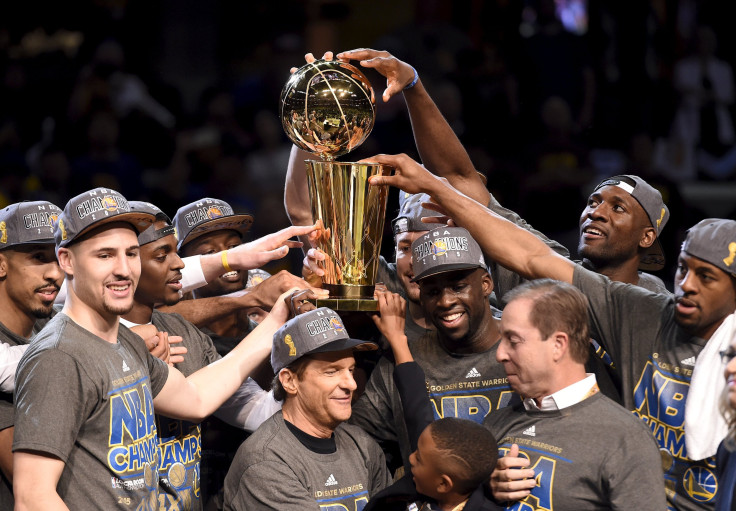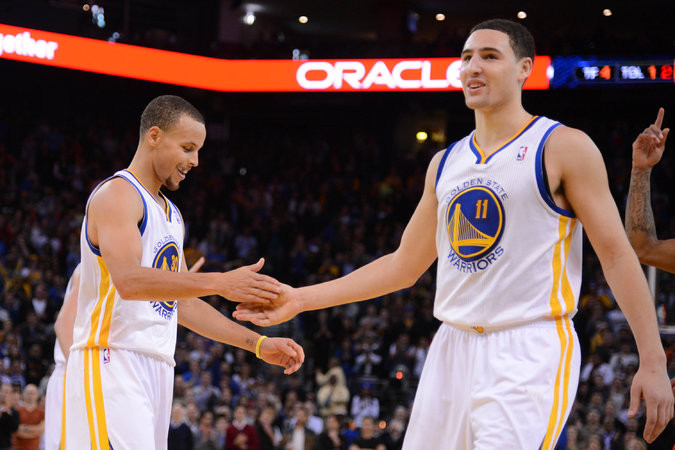Golden State Warriors: Champions In 2015, But Are More Titles On The Way?

After four decades of winning a total of just seven playoff series, the Golden State Warriors shed their underachiever label on Tuesday night, defeating the Cleveland Cavaliers in six games to win the 2015 NBA Finals, their first title since Rick Barry, Jamaal Wilkes, Clifford Ray and Butch Beard won in 1975.
Indeed, it has been a long and painful road for the Warriors. Joe Barry Carroll couldn’t lift Golden State in the 1980s, and head coach Don Nelson's "Run T-M-C" era of Tim Hardaway, Mitch Richmond and Chris Mullin consistently came up short in the deep Western conference in the early 1990s. From 1995 to 2012, it was even worse for Bay Area basketball, as the Warriors missed out on the postseason in 17 of 18 seasons and after 10 coaching changes.
But those days seem to be well behind the Warriors, and the future might be looking even brighter for Golden State to continue their success next season and beyond under first-year head coach Steve Kerr. Owners Joe Lacob and Peter Guber appear to have the foundation in place to maintain success for at least the next few seasons.
The core of the team is still Stephen Curry, and his fellow “Splash Brother” Klay Thompson. Curry won the MVP in a deep race, and even Thompson received some consideration from voters. The exciting backcourt is not only young and efficient, but also under contract beyond next season. Curry is making a relatively paltry sum of about $23.5 million over two seasons, and can become a free agent after the 2016-2017 season, while Thompson is signed through the 2018-2019 season.

General manager Bob Myers can take comfort in the Warriors' future with Curry and Thompson in the backcourt, as the pair combined to average nearly 47 points per game in the postseason, accounting for more than 45 percent of Golden State’s scoring. Curry is 27 years old, and Thompson is 25, which means Western Conference foes can expect to be pounded by more three-point shots.
But it’s the fate of the frontcourt that provides the most intrigue for Myers. Forward Draymond Green, who has been a workhorse for the Warriors since he was selected in the second round in 2012, is a restricted free agent this summer. The 25-year-old has been the Warriors’ most reliable defender and a fan favorite, but there has been some concern over whether he would stay with the club. The Warriors have the opportunity to match any team’s offer, and more than likely will do so to keep this group together for another run.
“Tell the Warrior fans they shouldn’t worry,” Myers said Tuesday, when asked about the team’s contract situations.
In the long term, especially from a financial and salary cap standpoint, there is potential for Golden State to build on this title and create the league’s next dynasty. That requires keeping this team together, with careful planning and deciding which players are more integral than others. However, several factors are left to consider.
Next season the Warriors have $78.7 million devoted to player contracts with the main parts from this title run already locked in, with Green being the lone exception. Considering his energy, defense, and all-around game, Green’s value on the restricted market could be upwards of $15 million, a number that will only escalate throughout the life of his next contract and eat into Golden State’s cap.
Yet with salary cap ceiling increasing in the 2016-2017 season thanks to the NBA’s $24 billion television rights deal with ESPN and Turner Broadcasting, the Warriors will get some extra room in the second year of Green’s potential deal. How much is unclear, but some projections indicate the cap could surpass the $100 million threshold over the next two or three seasons.
The Warriors are currently on the hook for only $50.9 million in salary in the 2016-17 season. In the summer of 2017, center Andrew Bogut and Finals MVP Andre Iguodala come off the books at a whopping $22.1 million. Curry will also be a free agent, but it would be hard to believe that either he or the Warriors would want to part ways.
What really helps is Thompson’s deal. Opting for security rather than hitting the open market, Thompson signed a four-year extension in 2014 that didn’t kick in until this season, and the deal set the table for the rest of Golden State’s cap. The most Thompson will be paid is $18.9 million in the final year of the contract, a figure that could have been much higher if he decided to test free agency last summer.
Curry's contract also provides more flexibility. Before he exploded to lead Golden State to 67 wins and took home the league MVP, Curry was a solid and developing player who endured a difficult ankle injury that sidelined him for all but 26 games in the 2011-2012 season. Like Thompson, he didn’t heckle with the Warriors and took a four-year, $44 million extension that began two years ago.
With Curry, Thompson and Green (likely) intact, Myers and ownership will need to decide whether the likes of Bogut, Iguodala, forward Harrison Barnes, and guard Shaun Livingston are worth eating into the cap.
Bogut, 30, provides decent help on the boards and can block shots, but the Warriors can find another serviceable big man either in the draft or in free agency without paying more than $11 million a season. Iguodala’s value could very well be on the rise after his stellar play in the finals, working so well as the second or third scoring option when Curry and Thompson struggled. But he’s 31 with 10 years already logged in the NBA, and unless Iguodala’s willing to take less money and fewer years in order to win another title, Golden State’s best bet is allowing him to walk.
Instead, Livingston and Barnes are right in the sweet spot of the Warriors' finances. Golden State holds a $5.7 million option on Livingston’s deal in 2016, and as back-up guards go that’s a bargain for a player capable of lockdown defense in the backcourt and at small forward. He also provides timely buckets in crunch time, and his excellent size at 6-foot-7 can overtake smaller guards on offense.
Barnes, 23, who made great strides this season, could have a qualifying offer in 2016 starting at roughly $5 million. Golden State might not be as enthusiastic about matching any offer Barnes receives as a restricted free agent, but the starting point is low enough that the right deal could be struck.
There are also smaller pieces to consider. Leandro Barbosa is an unrestricted free agent, but it’s unclear if the Warriors plan to bring back the veteran guard. At age 32, he proved to be a valuable bench player, averaging 7.1 points per game on 47.4 percent shooting in the regular season. But the Warriors may consider his price tag too expensive, and may entertain offers for another playmaker.
Center David Lee, who had an uneven season due to injuries, has an expiring $15.4 million contract next season. The Warriors may decide to hold onto the 32-year-old, though he would have to take a significant reduction in salary. In 2013-2014, Lee posted strong numbers, but whether he can be effective beyond next season will depend on his health. Marc Stein of ESPN reported that the Warriors may trade Lee to avoid paying a luxury tax on his bloated deal.
There are other big men who will likely stick around for next season, and perhaps longer. The Warriors hold a team option on Marreese Speights, who averaged 10.4 points per game, and shot 49.2 percent from the field. Speights, 27, is expected to return, but his future beyond next season is unclear. Former 2012 first-round draft pick Festus Ezeli has two years left on his contract. The 25-year-old averaged just 4.4 points per game, and may need to refine his game if he expects to receive more playing time and a new contract with the Warriors in two years time.
Myers can possibly find more depth from not only free agency but the draft. Golden State will have the No. 30 selection in the 2015 NBA Draft, and still have their first and second-round picks in 2016. Those picks are not likely to land another Curry or Thompson, but Myers may use them to add bench depth or at best develop a complimentary starter.
Overall, the Warriors have made significant progress that should carry over into next season. It seems like a distant memory that Lacob was loudly booed at Oracle Arena three years ago. Now, the Warriors will be looking to add some small pieces to repeat, and perhaps cash in on the star-studded 2016 free-agent market that could be enticed by the idea of competing for titles with Curry and Thompson. With the star guards in their prime, and with the likeable Kerr as head coach, it doesn't seem far-fetched.
It also helps that Lacob is not afraid to spend. He told Sean Deveney of the Sporting News that he has winning on his mind, even if that means dropping more money on players.
"I don’t want to pay the luxury tax, nobody wants to," Lacob said. "That’s why it is a luxury tax, it is very punitive. But if it means winning vs. not winning, I choose winning. So that’s not an issue. At the end of the day, all the things we are talking about are important, but the fans care about one thing: Are you winning? Not the luxury tax. If I am not here to win, then I shouldn’t be here. We need to win.”
The way the cap shakes out over the next two seasons, the table is certainly set for the Warriors to push for at least one more title before difficult decisions must be made. A dynasty is impossible to predict, but this doesn’t figure to be a franchise that will go another 40 years without a title or trudge through a rebuild anytime soon.
Bobby Ilich contributed to this report
© Copyright IBTimes 2024. All rights reserved.





















